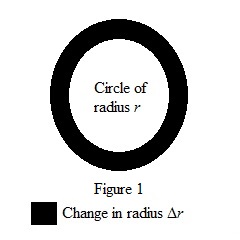
Concept explainers
(a)
(i)
The average rate of change of the area of a circle with respect to its radius
(a)
(i)
Answer to Problem 13E
The average rate of change of the area of a circle is
Explanation of Solution
Expression for the area of the circle is given as below.
Calculate the average rate of change of the area of a circle, when the radius changes from 2 to 3.
Therefore, the average rate of change of the area of a circle is
(ii)
The average rate of change of the area of a circle with respect to its radius
(ii)
Answer to Problem 13E
The average rate of change of the area of a circle is
Explanation of Solution
Calculate the average rate of change of the area of a circle, when the radius changes from 2 to 2.5.
Therefore, the average rate of change of the area of a circle is
(iii)
The average rate of change of the area of a circle with respect to its radius
(iii)
Answer to Problem 13E
The average rate of change of the area of a circle is
Explanation of Solution
Calculate the average rate of change of the area of a circle, when the radius changes from 2 to 2.1.
Therefore, the average rate of change of the area of a circle is
b)
The instantaneous rate of change when r = 2.
b)
Answer to Problem 13E
When r is 2 the instantaneous rate of change is
Explanation of Solution
Calculate the instantaneous rate of change when
Differentiate the above area equation,
Substitute the value
Therefore, when the value of
c)
To show: The rate of change of the area of a circle with respect to its radius is equal to the circumference of the circle and why it is geometrically true.
c)
Answer to Problem 13E
It is geometrically true. Hence, the resulting change in area
Explanation of Solution
Show that the rate of change of the area of a circle with respect to its radius is equal to the circumference of the circle.
Circumference of the circle is given as below.
First derivative of the area of the circle is given as below from the equation (1).
Compare both the equations (1) and (2).
Consider a circular ring of radius r and strip of thickness

Show that if the value of
Explain why it is geometrically true.
Approximate the resulting change in area
Write the expression for
The value of
Hence, it is proved.
Chapter 3 Solutions
Single Variable Calculus: Concepts and Contexts, Enhanced Edition
- For each graph in Figure 16, determine whether f (1) is larger or smaller than the slope of the secant line between x = 1 and x = 1 + h for h > 0. Explain your reasoningarrow_forwardPoints z1 and z2 are shown on the graph.z1 is at (4 real,6 imaginary), z2 is at (-5 real, 2 imaginary)Part A: Identify the points in standard form and find the distance between them.Part B: Give the complex conjugate of z2 and explain how to find it geometrically.Part C: Find z2 − z1 geometrically and explain your steps.arrow_forwardA polar curve is represented by the equation r1 = 7 + 4cos θ.Part A: What type of limaçon is this curve? Justify your answer using the constants in the equation.Part B: Is the curve symmetrical to the polar axis or the line θ = pi/2 Justify your answer algebraically.Part C: What are the two main differences between the graphs of r1 = 7 + 4cos θ and r2 = 4 + 4cos θ?arrow_forward
- A curve, described by x2 + y2 + 8x = 0, has a point A at (−4, 4) on the curve.Part A: What are the polar coordinates of A? Give an exact answer.Part B: What is the polar form of the equation? What type of polar curve is this?Part C: What is the directed distance when Ø = 5pi/6 Give an exact answer.arrow_forwardNew folder 10. Find the area enclosed by the loop of the curve (1- t², t-t³)arrow_forward1. Graph and find the corresponding Cartesian equation for: t X== y = t +1 2 te(-∞, ∞) 42,369 I APR 27 F5 3 MacBook Air stv A Aa T 4 DIIarrow_forward
- Middle School GP... Echo home (1) Addition and su... Google Docs Netflix Netflix New folder 9. Find the area enclosed by x = sin²t, y = cost and the y-axis.arrow_forward2. Graph and find the corresponding Cartesian equation for: (4 cos 0,9 sin 0) θ ε [0, 2π) 42,369 I APR 27 3 MacBook Air 2 tv A Aaarrow_forward30 Page< 3. Find the equation of the tangent line for x = 1+12, y = 1-3 at t = 2 42,369 APR A 27 M . tv NA 1 TAGN 2 Aa 7 MacBook Air #8arrow_forward
 Calculus: Early TranscendentalsCalculusISBN:9781285741550Author:James StewartPublisher:Cengage Learning
Calculus: Early TranscendentalsCalculusISBN:9781285741550Author:James StewartPublisher:Cengage Learning Thomas' Calculus (14th Edition)CalculusISBN:9780134438986Author:Joel R. Hass, Christopher E. Heil, Maurice D. WeirPublisher:PEARSON
Thomas' Calculus (14th Edition)CalculusISBN:9780134438986Author:Joel R. Hass, Christopher E. Heil, Maurice D. WeirPublisher:PEARSON Calculus: Early Transcendentals (3rd Edition)CalculusISBN:9780134763644Author:William L. Briggs, Lyle Cochran, Bernard Gillett, Eric SchulzPublisher:PEARSON
Calculus: Early Transcendentals (3rd Edition)CalculusISBN:9780134763644Author:William L. Briggs, Lyle Cochran, Bernard Gillett, Eric SchulzPublisher:PEARSON Calculus: Early TranscendentalsCalculusISBN:9781319050740Author:Jon Rogawski, Colin Adams, Robert FranzosaPublisher:W. H. Freeman
Calculus: Early TranscendentalsCalculusISBN:9781319050740Author:Jon Rogawski, Colin Adams, Robert FranzosaPublisher:W. H. Freeman
 Calculus: Early Transcendental FunctionsCalculusISBN:9781337552516Author:Ron Larson, Bruce H. EdwardsPublisher:Cengage Learning
Calculus: Early Transcendental FunctionsCalculusISBN:9781337552516Author:Ron Larson, Bruce H. EdwardsPublisher:Cengage Learning





